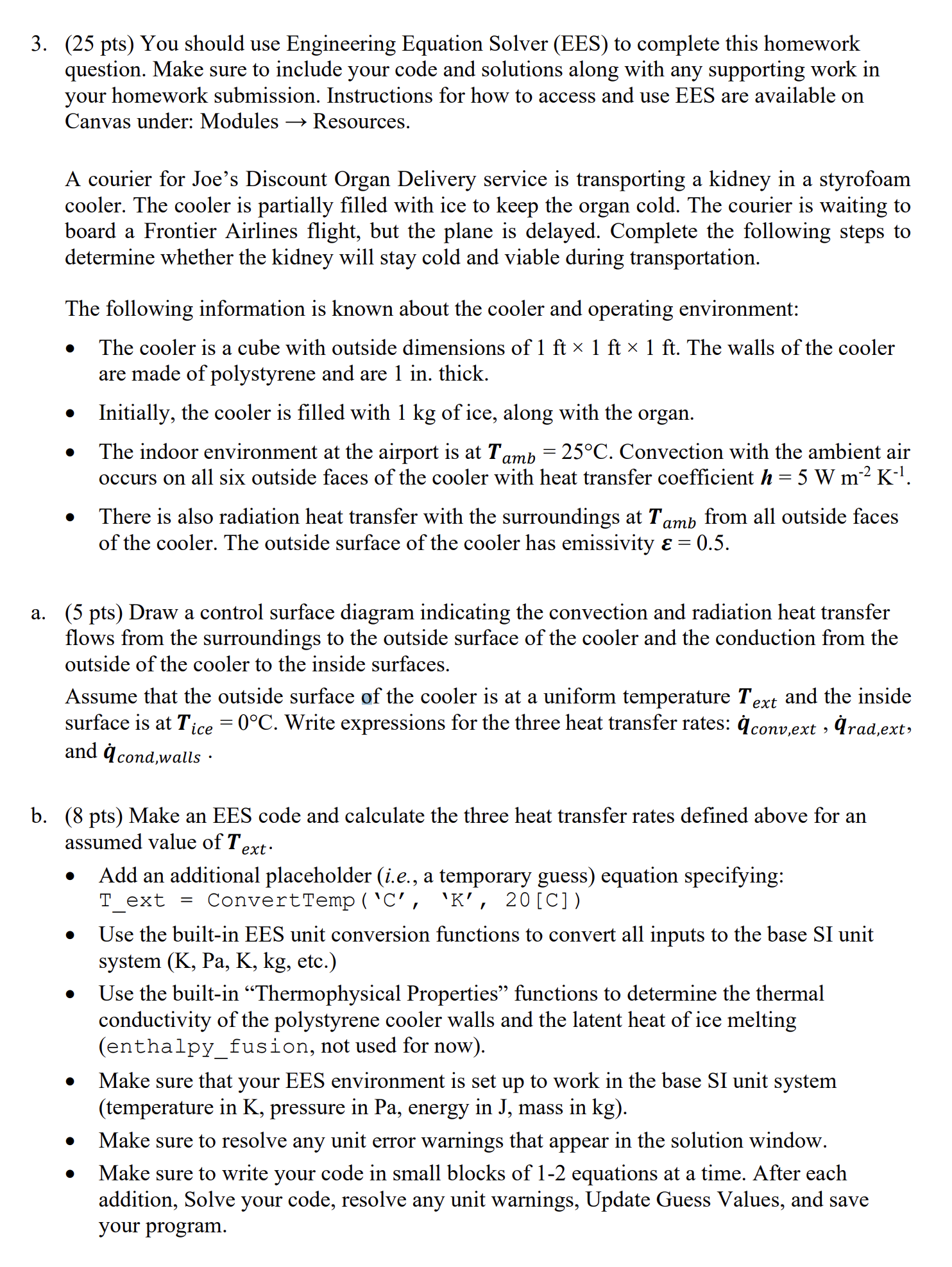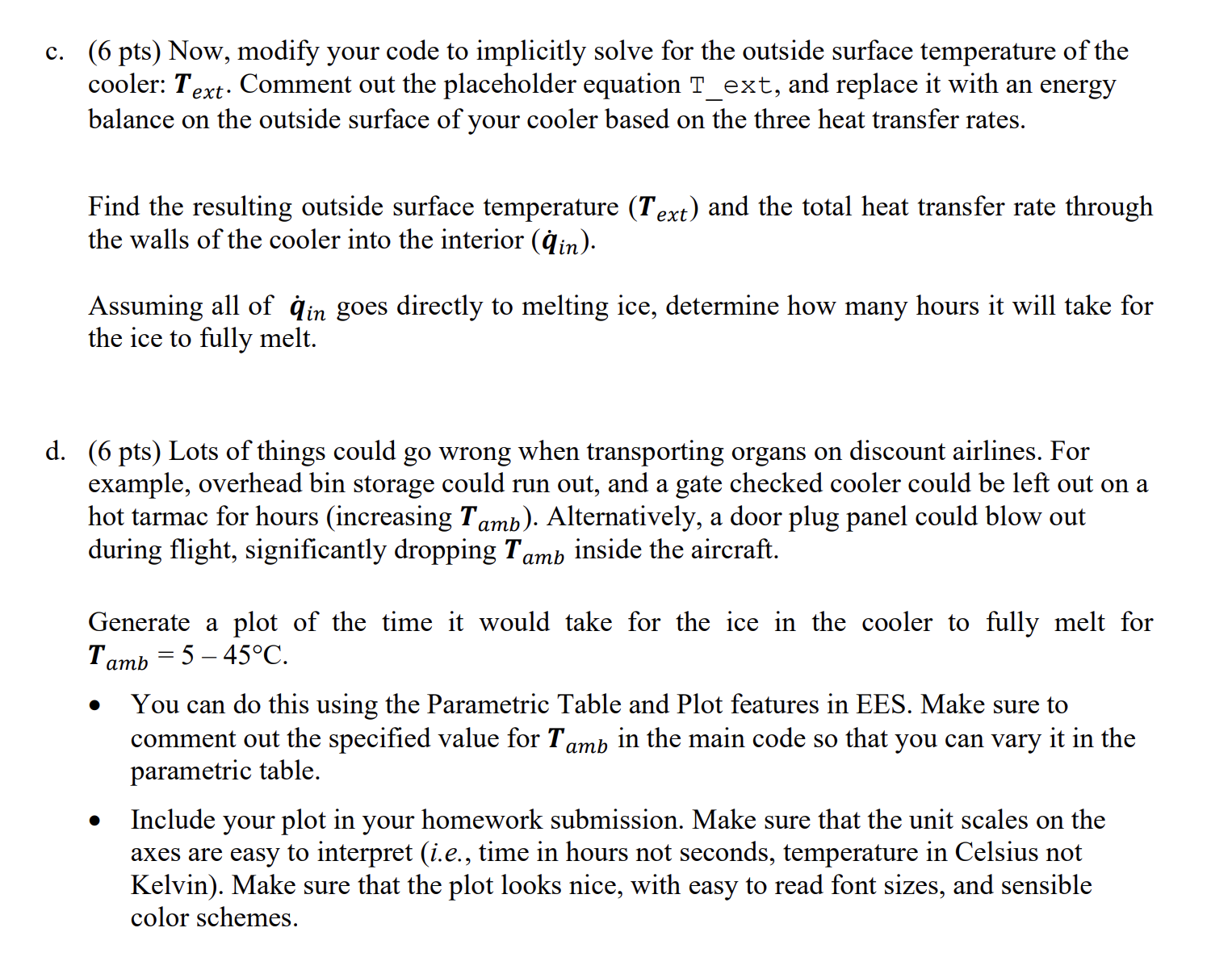Answered step by step
Verified Expert Solution
Question
1 Approved Answer
3. (25 pts) You should use Engineering Equation Solver (EES) to complete this homework question. Make sure to include your code and solutions along


3. (25 pts) You should use Engineering Equation Solver (EES) to complete this homework question. Make sure to include your code and solutions along with any supporting work in your homework submission. Instructions for how to access and use EES are available on Canvas under: Modules - Resources. A courier for Joe's Discount Organ Delivery service is transporting a kidney in a styrofoam cooler. The cooler is partially filled with ice to keep the organ cold. The courier is waiting to board a Frontier Airlines flight, but the plane is delayed. Complete the following steps to determine whether the kidney will stay cold and viable during transportation. The following information is known about the cooler and operating environment: The cooler is a cube with outside dimensions of 1 ft 1 ft 1 ft. The walls of the cooler are made of polystyrene and are 1 in. thick. Initially, the cooler is filled with 1 kg of ice, along with the organ. The indoor environment at the airport is at Tamb = 25C. Convection with the ambient air occurs on all six outside faces of the cooler with heat transfer coefficient h = 5 W m K-. a. (5 pts) Draw a control surface diagram indicating the convection and radiation heat transfer flows from the surroundings to the outside surface of the cooler and the conduction from the outside of the cooler to the inside surfaces. Assume that the outside surface of the cooler is at a uniform temperature Text and the inside surface is at Ti "ice = 0C. Write expressions for the three heat transfer rates: conv,ext rad,ext, and a cond,walls There is also radiation heat transfer with the surroundings at Tamb from all outside faces of the cooler. The outside surface of the cooler has emissivity = 0.5. b. (8 pts) Make an EES code and calculate the three heat transfer rates defined above for an assumed value of T ext Add an additional placeholder (i.e., a temporary guess) equation specifying: T_ext = Convert Temp (`C', 'K', 20[C]) Use the built-in EES unit conversion functions to convert all inputs to the base SI unit system (K, Pa, K, kg, etc.) Use the built-in "Thermophysical Properties" functions to determine the thermal conductivity of the polystyrene cooler walls and the latent heat of ice melting (enthalpy_fusion, not used for now). Make sure that your EES environment is set up to work in the base SI unit system (temperature in K, pressure in Pa, energy in J, mass in kg). Make sure to resolve any unit error warnings that appear in the solution window. Make sure to write your code in small blocks of 1-2 equations at a time. After each addition, Solve your code, resolve any unit warnings, Update Guess Values, and save your program. c. (6 pts) Now, modify your code to implicitly solve for the outside surface temperature of the cooler: Text. Comment out the placeholder equation T_ext, and replace it with an energy balance on the outside surface of your cooler based on the three heat transfer rates. Find the resulting outside surface temperature (Text) and the total heat transfer rate through the walls of the cooler into the interior (in). Assuming all of in goes directly to melting ice, determine how many hours it will take for the ice to fully melt. d. (6 pts) Lots of things could go wrong when transporting organs on discount airlines. For example, overhead bin storage could run out, and a gate checked cooler could be left out on a hot tarmac for hours (increasing Tamb). Alternatively, a door plug panel could blow out during flight, significantly dropping Tamb inside the aircraft. Generate a plot of the time it would take for the ice in the cooler to fully melt for Tamb=5 -45C. You can do this using the Parametric Table and Plot features in EES. Make sure to comment out the specified value for Ta in the main code so that you can vary it in the parametric table. amb Include your plot in your homework submission. Make sure that the unit scales on the axes are easy to interpret (i.e., time in hours not seconds, temperature in Celsius not Kelvin). Make sure that the plot looks nice, with easy to read font sizes, and sensible color schemes.
Step by Step Solution
There are 3 Steps involved in it
Step: 1

Get Instant Access to Expert-Tailored Solutions
See step-by-step solutions with expert insights and AI powered tools for academic success
Step: 2

Step: 3

Ace Your Homework with AI
Get the answers you need in no time with our AI-driven, step-by-step assistance
Get Started


